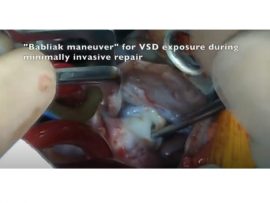Abstract OBJECTIVES Implanting a durable left ventricular assist device (LVAD) in a patient on extracorporeal life support (ECLS) is challenging. The goal of this study was to compare..
Read MoreAbstract The use of clinical debriefing promotes team reflexivity, aligns with Safety II principles and allows organisation leaders to engage clinicians in collaborative change. There is ample evidence of its..
Read MoreAbstract Background Suboptimal tissue perfusion and oxygenation may be the root cause of certain perioperative complications in neonates and infants having complicated aortic coarctation repair. Practical, effective, and real-time monitoring..
Read MoreAbstract Study objective To test the hypotheses that in adults having cardiac surgery with cardio-pulmonary bypass, perioperative hypotension increases the risk of delirium and atrial fibrillation during the initial five..
Read MoreAbstract The aim of the study was to evaluate the effectiveness of a new technology for the use of inhaled nitric oxide (NO) for the heart and lung protection during operations..
Read MoreAbstract Patients with bilateral high degree carotid stenosis or occlusion impose high risk for neurological complications during coronary arterial bypass surgery (CABG). Former articles have described successful CABG in patients..
Read MoreAbstract Background Cerebral autoregulation (CA) impairment is associated with neurological complications among children supported by extracorporeal membrane oxygenation (ECMO). Severe variations of arterial CO2 (PaCO2) and O2 (PaO2) tension after ECMO onset..
Read MoreAbstract Introduction: Although the management of body water balance on cardiac surgery with cardiopulmonary bypass (CPB), especially in children, is essential, little is known how body water composition changes around CPB...
Read MoreThis case reports on a 49-year-old female patient who presented to hospital with locally advanced carcinoma of the pancreatic head with jaundice, weight loss, abdominal pain and ascites already manifested...
Read MoreAbstract Background Chronic obstructive pulmonary disease, cystic fibrosis and usual interstitial pneumonia are three most common indications for lung transplantation (LuTx) in Poland. As a result of irreversible destruction of..
Read MoreAbstract Objectives Heparin resistance (HR), defined as a decrease in heparin responsiveness, can result in adverse events with prolonged duration of surgery. Although some clinical risk factors have been suggested,..
Read MoreAbstract Background: Vasoplegic syndrome (VPS) is defined as systemic hypotension due to profound vasodilatation and loss of systemic vascular resistance (SVR), despite normal or increased cardiac index, and characterized by..
Read MorePatient with BAV bicuspid aortic valve and free valve perforation due to endocarditis undergone valve replacement with mechanical valve Livanova. Dr.Sam Zeraatian Nejad Davani, CEO of rockingham medical research ADKWA..
Read MoreAbstract Background To determine whether maintaining ventilation during cardiopulmonary bypass (CPB) with a different fraction of inspired oxygen (FiO2) had an impact on the occurrence of postoperative pulmonary complications (PPCs)...
Read MoreAbstract Surgical research has shifted from the laboratory focus of the mid to late 20th century to a more mixed economy of data science, collaborative and qualitative research, with a..
Read MoreAbstract Background The optimal strategy for cerebral protection during repair of type A acute has yet to be determined. We sought to determine the impact of differing degrees of hypothermia in..
Read MoreAbstract The objective of clinical research is to establish ethically and methodologically sound evidence that can aid clinical decision-making, inform ongoing research and add to the existing body of knowledge...
Read MoreAbstract BACKGROUND Patients with three-vessel coronary artery disease have been found to have better outcomes with coronary-artery bypass grafting (CABG) than with percutaneous coronary intervention (PCI), but studies in which..
Read MoreAbstract Background: Acute kidney injury (AKI) is associated with high morbidity and mortality; therefore, prevention is important. The aim of this study was to systematically assess AKI incidence after cardiac surgery..
Read MoreAbstract Anesthesiologists are important components of volunteer teams which perform congenital cardiac surgery in low-resource settings throughout the world, but limited data exist to characterize the nature and breadth of..
Read MoreAbstract Perioperative myocardial infarction is a serious complication affecting a significant portion of patients undergoing coronary artery bypass graft surgery. This may arise due to coronary graft thrombosis, a rare..
Read MorePatient with very very low LVEF and severe MR in TEE and TTE as you can see just with SVR surgical ventricular restoration and CABG MR completely reduced as you..
Read MoreOften we come upon pauses on 12-lead ECGs and rhythm strips. Some of these pauses have durations that we are simply unable to justify while others are easier to comprehend...
Read MoreEducational video. The less traumatic and best cosmetic approach for children with congenital heart defects is Right Axillary Mini-Thoracotomy. The problem with complex defects repair through the Right Axillary MIni..
Read MoreIn the last years, new trends on patient diagnosis for admission in cardiac intensive care unit (CICU) have been observed, shifting from acute myocardial infarction or acute heart failure to..
Read MoreAbstract Background: The decision about whether to use venoarterial extracorporeal membrane oxygenation (VA-ECMO) in patients with cardiac graft dysfunction (GD) is usually made on a case-by-case basis and is guided by..
Read MoreAbstract Introduction and objectives Lactate and its evolution are associated with the prognosis of patients in shock, although there is little evidence in those assisted with an extracorporeal venoarterial oxygenation..
Read More






















